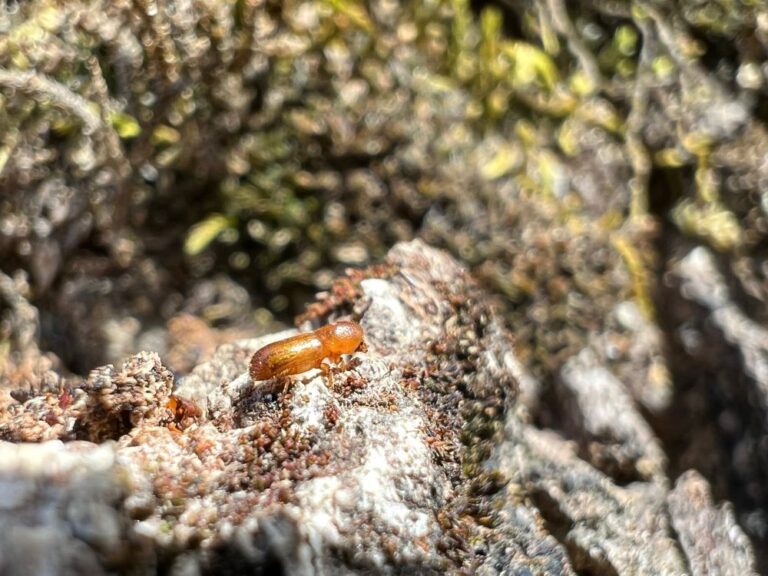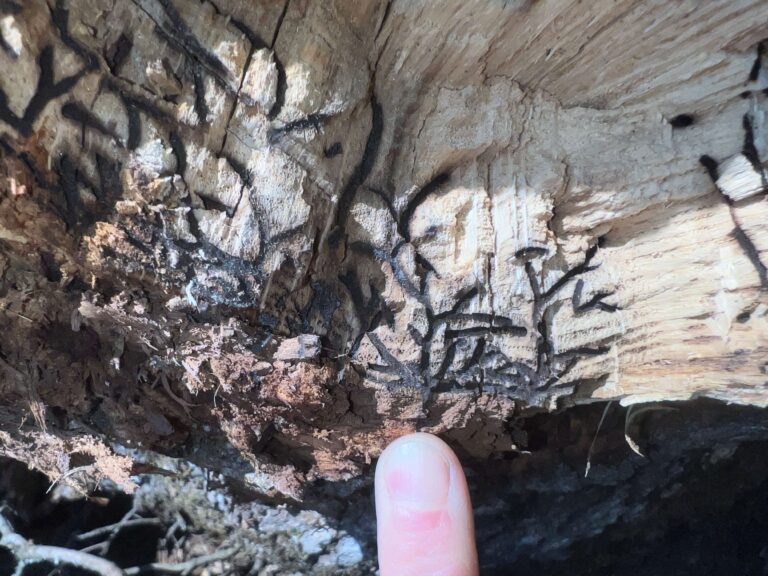News
All about the Mediterranean Oak Borer: Ways to limit its spread and protect Oaks
A tree exhibiting signs of MOB, as distinguished by the distinct section of dead leaves at the canopy. Photo: Christine Buhl, Oregon Department of Forestry
It might be a small beetle, but that doesn’t mean the Mediterranean Oak Borer can’t have big impacts. If you've never heard of the insect, the Mediterranean Oak Borer (MOB) is a small ambrosia beetle and oak pest first detected on the West Coast in 2017. Wyatt Williams, the Invasive Species Specialist with the Forest Health Unit of the Oregon Department of Forestry, recently shared information about the beetle, its impacts, and what we can do to both detect it and prevent its spread at both a joint Klamath-Siskiyou Oak Network and Umpqua Oak Partnership and an East Cascades Oak Partnership meeting.
What is it?
As its name suggests, the Mediterranean Oak Borer (MOB), Xyleborus monographus, hails from the Mediterranean region and is a minor pest of cork oak in its native range. The pest was first spotted in Napa County in 2017, and by 2019 had caused significant damage in the region. Today, it's been found in Central California and five counties in Northern Willamette Valley, Oregon, including wine country and more urban areas. Ambrosia beetles like MOB are common tree pests that tunnel into tree trunks, creating nurseries to lay eggs and farm fungus as food for their larvae. While in their native range, they attack only dead and decaying wood, scientists studying the Mediterranean Oak Borer here have evidence suggesting they attack both healthy and dying oaks in the introduced range.
When Mediterranean Oak Borers tunnel into the sapwood and heartwood of the tree, they interrupt the water transfer pathways and prevent the canopy from getting sufficient water. The fungus that they farm, Raffaelea montetyi, is a pathogen with unknown survival rates, that oaks have no natural resistance to. Tunneling and the introduction of these pathogens also weaken the trees, making them more susceptible to damage from other factors. Once the beetles have successfully raised their larvae, they have been observed to attack the same oak multiple times. After 3-5 years, this will cause the tree to wilt and die fully.


How do I identify it?
While this is scary, it's not all bad news – thanks to the close eyes and efficient work of scientists, there are resources available on what we can do to slow its spread. The first step: learn to identify it. Since the beetle is incredibly small, it is difficult to identify without expert advice, but there are signs you can look for.
As Wyatt shared, one of the big signs that a tree is impacted is the presence of fine, white boring dust around the tree bark, at eye level, and around the base. Looking towards the canopy, if you see sections with entirely healthy leaves, adjacent to others that are sagging, with wilting or shriveled brown leaves, that may be a sign of MOB. They have been observed to attack the small branches and the uppermost limbs before proceeding down to the main trunk, so keep an eye out for weakened or breaking branches, particularly at the canopy.
How do I know if my oak has MOB?
- Did the canopy recently show brown, shriveled, or wilted leaves in some sections, while others are healthy?
- Is there fine, white sawdust at the base of the tree or in bark crevasses?
- After taking a sample, do you see black staining and the characteristic branching gallery pattern in the wood?
Looking at a cross-section of a tree trunk or branch can provide further confirmation of infection. The MOB prefers to nest in the sapwood of 12" diameter stems and branches and both the sapwood and heartwood of smaller diameters. This is where they create branchy tunnels, or “galleries” to farm fungus for their larvae, leaving behind dark staining in the wood, another critical sign of the insect. Thus far, the pest is confirmed to host in: Valley Oak, Blue Oak, California Black Oak, English Oak, Northern Red Oak, Oregon White Oak, Chestnut, Beech, and other hardwoods.


What can we do about it?
So, what do you do if you identify an infected oak? First, let the Oregon Invasive Species or California Invasive Species hotline know, to ensure they can track the pest accurately. Once officials from ODF or ODA can confirm the culprit is MOB, the next step is to remove the infected section of the tree, or if the main trunk is infected, cut the tree down. To ensure the adults cannot fly away and infect other trees, experts recommend chipping the tree and covering the chippings with plastic or a tarp for six weeks minimum in the winter or six months in the summer. Another option is to burn the wood directly after cutting, without removing it from the cut site. After doing so, Wyatt emphasized the need to sanitize the tools as a normal precaution to prevent the spread of tree disease before moving to another site.


What do I do if I identify an infected tree?
- Contact your state invasive species hotline and community oak managers. Seek confirmation of MOB.
- If it is on your property, take action to remove the infected branches or the entire tree, if needed.
- Chip the cut wood and place it under a tarp for six weeks in winter or six months in summer. Alternatively, you can burn the wood at the cut site.
- Sanitize any tools used after cutting.
There are some methods available to protect uninfected oaks, such as heat treating imported wood products and firewood at 70°C (158°F) for 60 minutes, and not moving untreated wood products further than 30 miles. New methods for treating infected wood are also in the works, including refined chipping methods, solarization, fungicide application, and sanitization methods. Further insight is needed on if trapping can be utilized for the pest.
This situation is reminiscent of the Emerald Ash Borer (EAB), a similar insect that is predicted to cause severe losses of Oregon Ash trees in the coming decades. Despite this, new research is ongoing to determine if there are strains of Oregon Ash that are more resistant to the beetle and if it is possible to selectively breed resistant individuals to maintain populations.
This research may also have implications for the future of MOB. Although MOB poses a threat to already at-risk oak species, experts emphasizethat there is still a lot we don’t know about the pest and that we have caught it early in its invasion, giving hope to the situation. Scientists and land managers are working swiftly to determine the mortality rate and rate of spread, increase awareness, and provide resources on detecting, containing, and removing pests. You can find some of those resources at the links below, including recordings of presentations on the species, links to fact sheets, and the invasive species websites:
Oregon Invasive Species Hotline
California Invasive Species Hotline
California Department of Food and Agriculture Plant Pest Hotline
KSON Quarterly Meeting Recording - Sept 21, 2023
East Cascades Oak Partnership Meeting - September 22, 2023
Oregon Department of Forestry Fact Sheet on MOB
Oregon Department of Forestry Oak Pests Fact Sheet
Oregon Department of Forestry Press Release
Article on MOB from University of California Agriculture and Natural Resources
